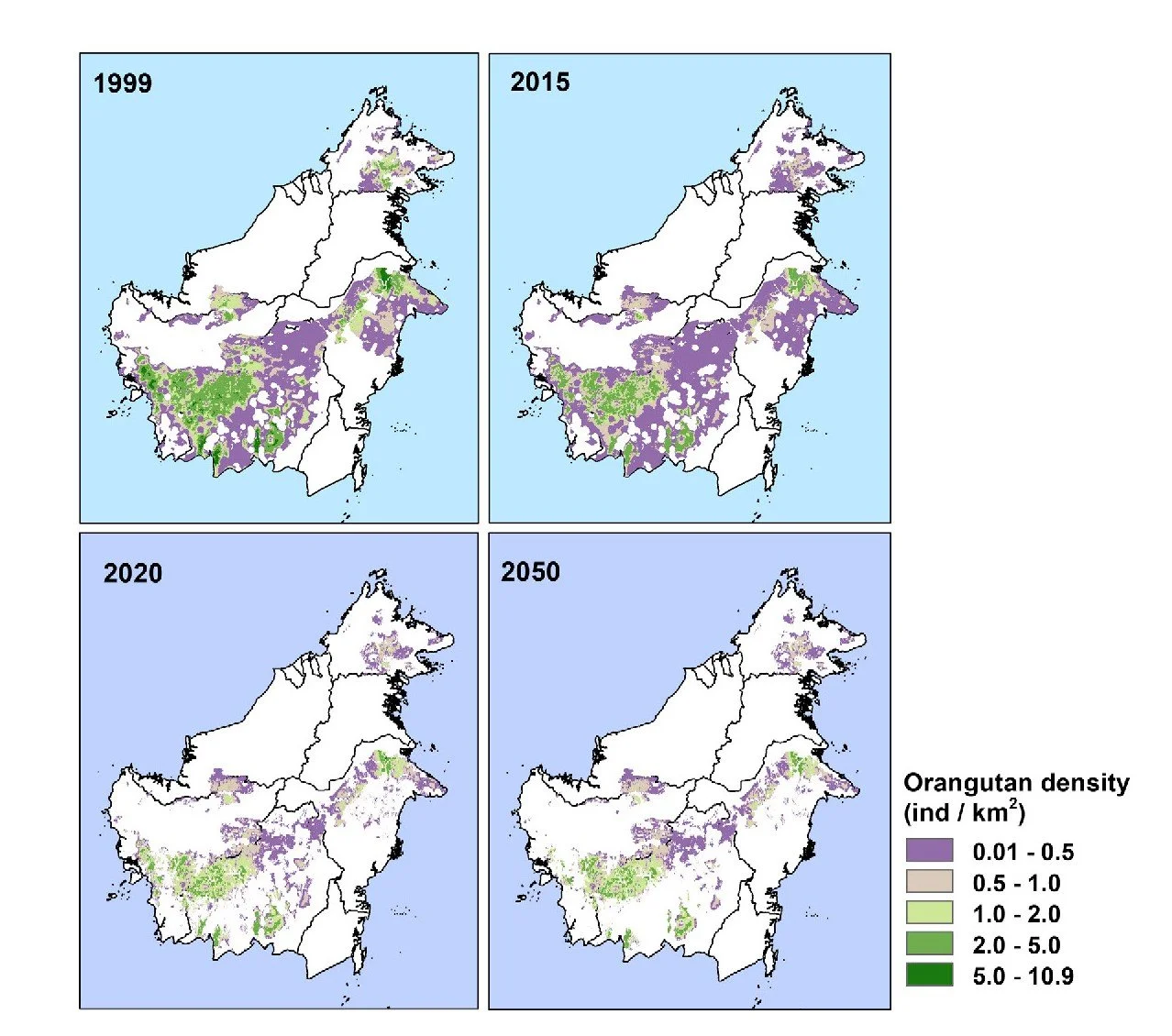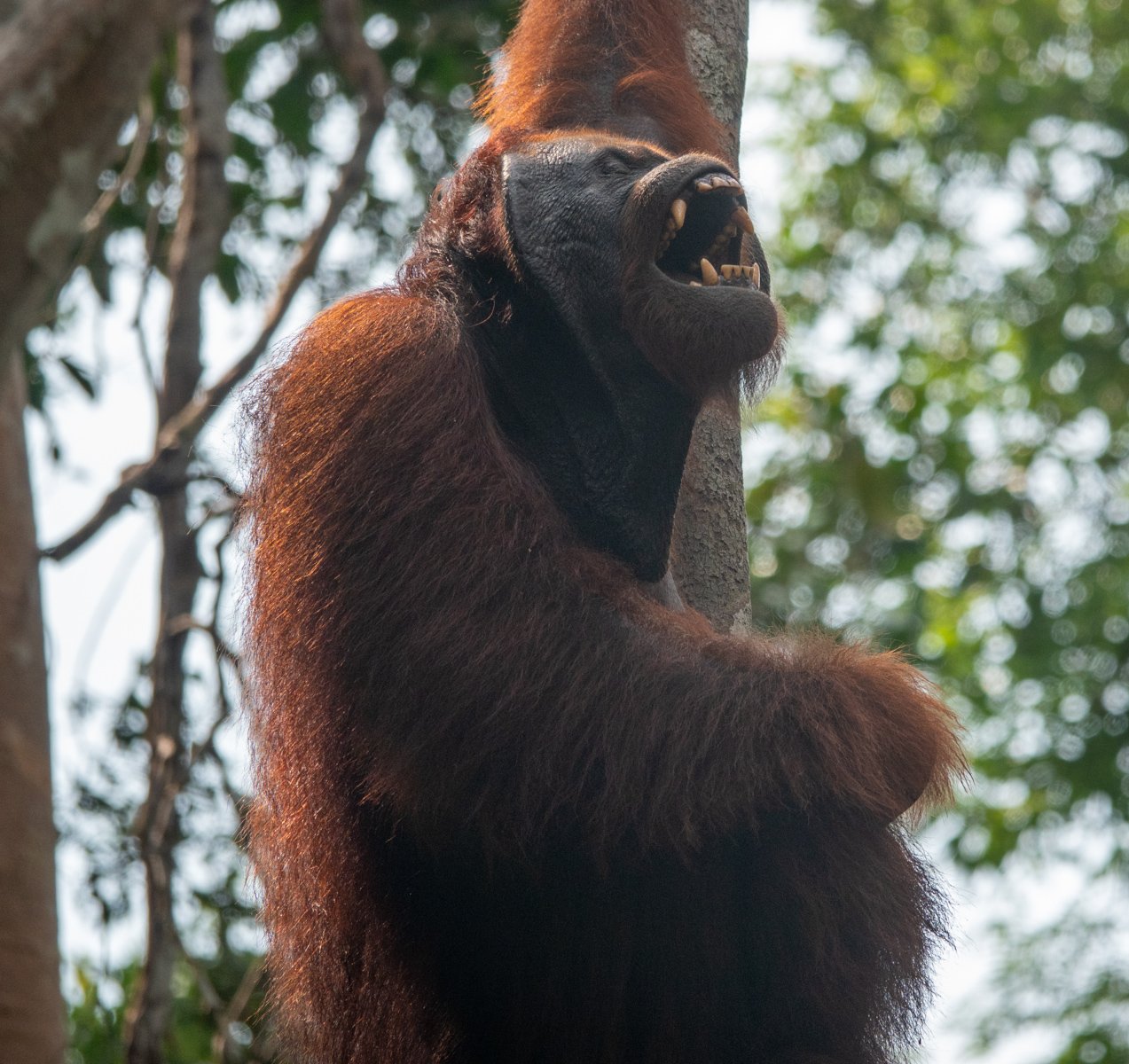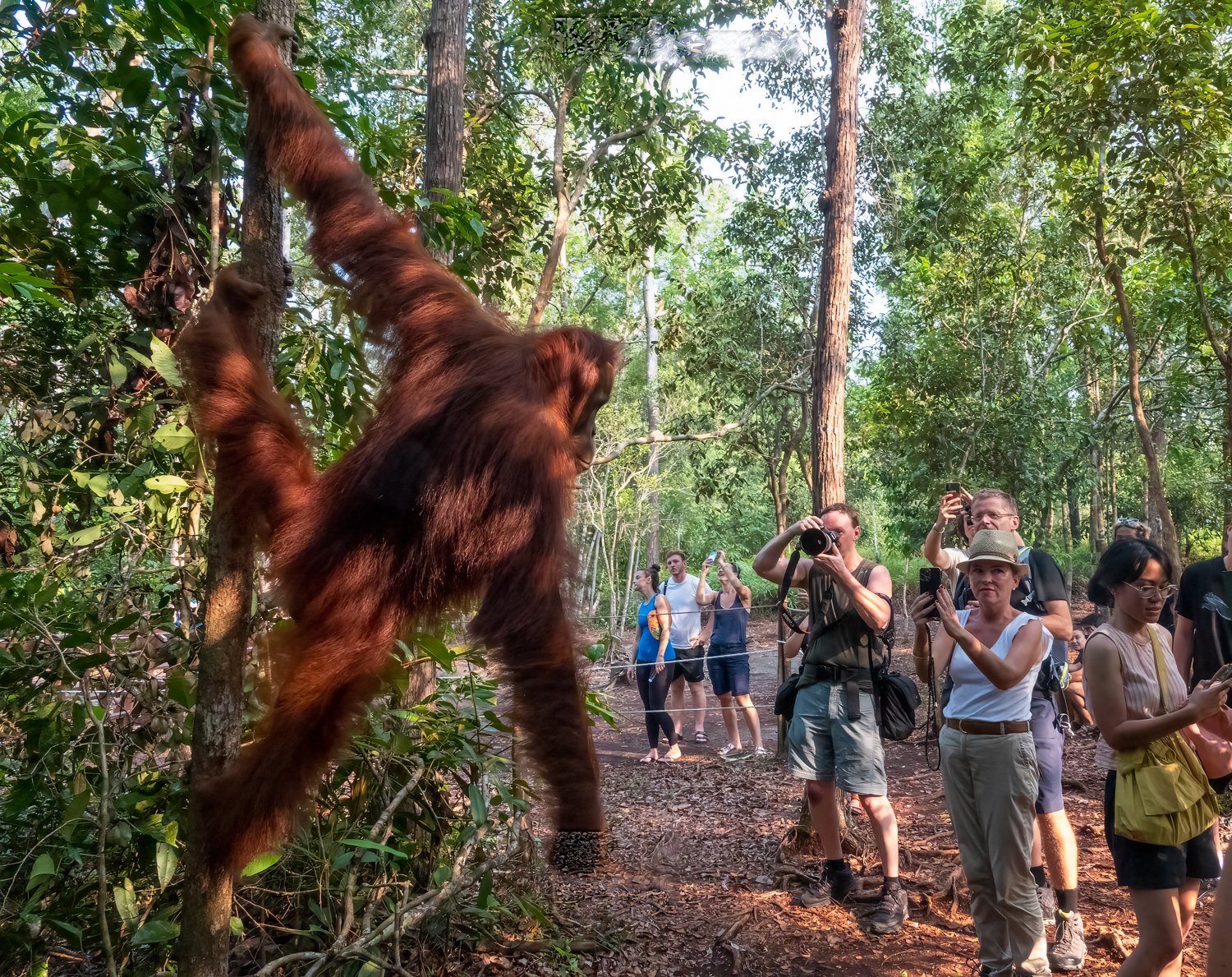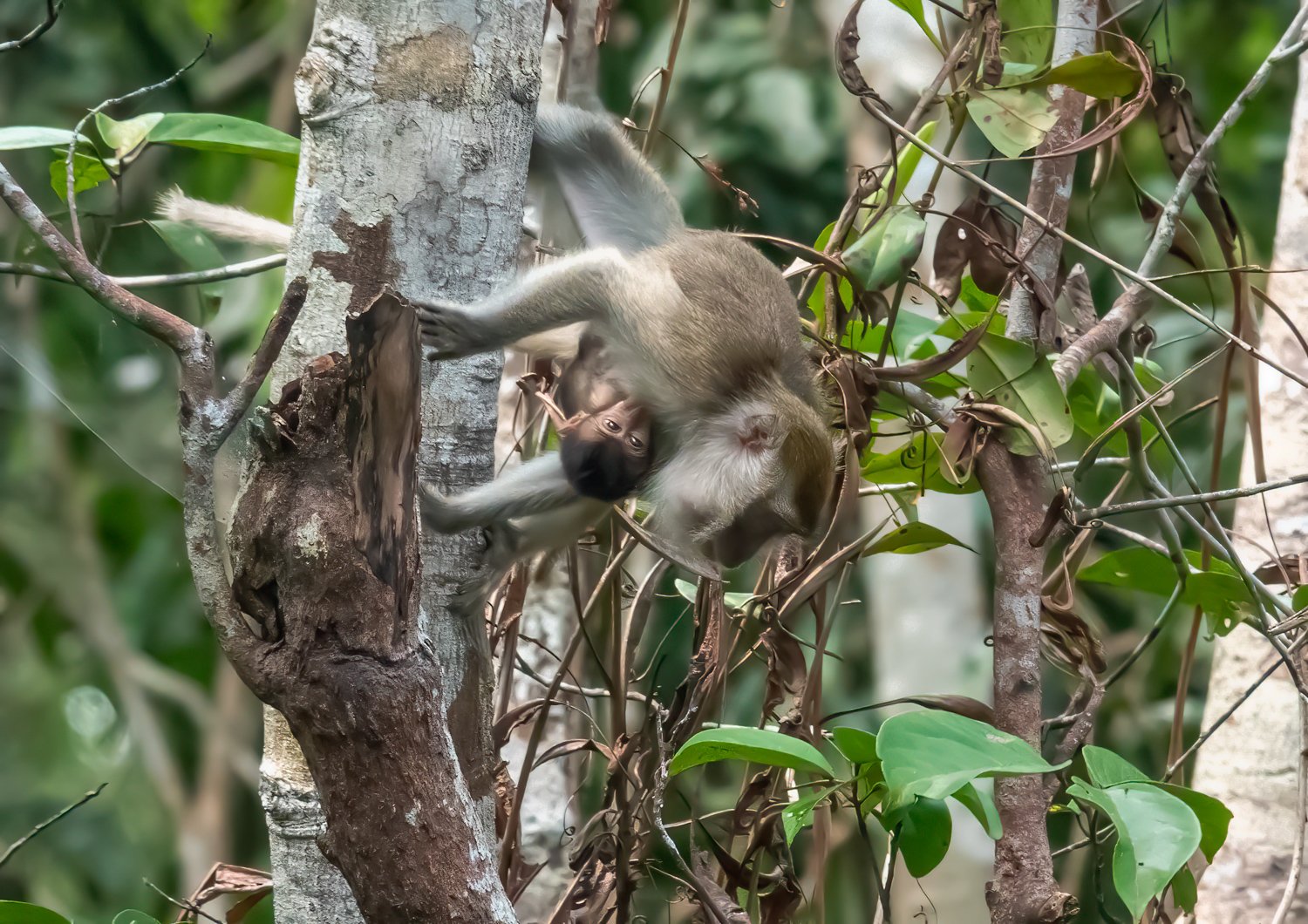Orangutans in Borneo
In November, 2023 I went to Borneo for a short but spirited trip to see orangutans in the wild. The trip was the first part of a longer one to Indonesia which I will write up separately, as the orangutans deserve their own blog. For me this completed my tour of the great apes this year, as I had seen gorillas and chimpanzees in the wild in Rwanda in the summer.
I took an early morning 5:30 AM flight from Jakarta to Pangkalan Bun on the southern end of island of Kalimantan, or Borneo. (Fun fact: Borneo is the third largest island in the world, after Greenland and New Guinea). The standard way to see the orangutans is to cruise the Sekonyer River by houseboat, called klotok for the sound of the engines (“klok tok tok tok”). One spends the entire time on the boat with the exception of getting off to hike to see the orangutans. Part of the appeal of this tour is to be close to the jungle, sleeping with sounds of the jungle though protected by mosquito netting.
If you would like to see and hear the stories behind many of the photos and videos in this blog, I gave a Zoom presentation to the Photo Midwest Third Thursday talk on June 19, 2025. The presentation was recorded and is available here. It includes photos of my trip to Rwanda .to trek with gorillas and chimpanzees.
Both images adapted from Reflections of Eden, My Years with the Orangutans of Borneo, by Birute Galdikas (1995)
Unfortunately, the organgutans are not benefitting from ecotourism like the mountain gorillas. In fact their numbers in Indonesia are dropping precipitously in parallel with their loss of habitat as palm oil plantations replace rain forest.
Orangutan numbers in Borneo have dropped almost 50% since 2000. From Voigt et al., 2018, Current Biology 28, 761–769 March 5, 2018
The loss in orangutan numbers is reflected in the loss of rainforest.
I signed up for a tour with Jenie Subaru who was recommended by Lonely Planet. His operation is family-run (most of the people working on the tour seem to be related to him) and he is also active in giving back to help the apes.
My tour with Jenie was arranged a few months beforehand sandwiched between my various trips to Africa and California. On the plane ride there I had checked my email and discovered that I had never paid him, which was a bit disconcerting. But he had sent me several texts assuring me that I would be met at the airport, which was indeed the case. The taxi driver let me off in front of a dilapidated house in the small river town of Kumai which serves as the focal point of the river tours. There was no sign about Jenie’s tour, as I was expecting to be taken to the office. There was an old man in his undies sleeping on an old couch and the house reminded me of shacks in Appalachia in the 60s. I actually don’t know if Jenie lived there or not, because I was led to the back of the house which was on the river and there were a series of houseboats that were tied up there. Perhaps he just uses the house for boat parking. In any case it was initially a bit disconcerting but the boats were in better shape than the house.
As Jenie and I were chatting after our initial meeting, I mentioned that I didn’t think I had paid him and he seemed surprised. We then had to figure out a way for me to pay him as he didn’t take credit cards. Normally it would have been paid by an international bank transfer from the US. However, that was no longer possible. We finally decided to try using the ATM, which I had successfully used in Jakarta the previous day. So he took me on the back of his motorcycle into town where we were able to get the $400+ from the ATM.
Jenie taking my photo as we push off
Jenie’s video of our departure. My guide Sandy is pushing us off.
Note on viewing the embedded videos
Unfortunately viewing the videos successfully appears to depend very much on your internet speed. In my limited experience, it needs to be >50 Mbps to load properly.
Visiting orangutans by klotok
I was the only guest on a klotok with a crew of four: an English-speaking guide, driver, cook and general handyman. I was on the boat for 3 days and 2 nights and never met the cook until the very last day when we returned home. The boat has two stories: the crew is downstairs while the guests stay upstairs. The boat I was on looked like it was designed for a couple as there was just a single queen sized mattress though the table could sit a family of 4. We also saw larger and more ornate boats. In general it was great to experience the jungle from such close quarters. Sitting on the houseboat watching the jungle pass by with the putt-putt sound of the motor made me imagine that Katharine Hepburn might climb up from the lower deck.
A typical lunch. The food was excellent and freshly cooked in the lower deck.
Top deck of my klotok
Turn sound on to get the full African Queen effect
For much of the ride the national park is on one side of the river and private land is on the other side. We saw several orangutans in the jungle as we cruised past, but they were largely obscured by the dense vegetation. However, one could track them somewhat by watching the tops of trees swaying as they cruised through them. In some places the jungle has been replaced with palm tree plantations, which represent the greatest threat to the orangutans. My guide Sandy pointed out a section of the jungle that Jenie purchased in order to keep the land from the palm oil companies to help preserve orangutan habitat. Short of investing in some Borneo real estate, it is difficult to know how to combat the loss of habitat to palm oil plantations. Palm oil is an insidious but very successful product found in thousands of everyday products so it is not easy to simply decrease one’s consumption. See how one can make a difference here.
View from the boat with palm tree plantations on both sides
A more elaborate klotok
One small caveat about the klotoks that one should be aware of. I was on the boat for two nights, three days, only getting off at the feeding stations. The boat comes equipped with all you need, including a Western-style flush toilet. However, as far as I could tell the toilet simply flushed into the river, though I’m not positive about that. In any case I tried to minimize my trips to the toilet on the boat and made use of the mainland toilets where at least the waste was filtered by soil. This worked out ok until the last day when I had 3 days worth of waste to dispose of. I was hoping to make it to the airport where I knew there were decent facilities. But Jenie wanted to make sure I saw all the sights in scenic Pangkalan Bun so he had Sandy escort me around. Finally I had to tell Sandy that I desperately needed a toilet. We were about to board a water taxi to meet Jenie and his family for lunch. Sandy found a toilet on the pier but it was high on my list of worst toilets ever experienced. There were two tiny rooms, one had no walls and the other was open to the river. And the ‘toilet’ was simply a hole cut in the planks of the floor with the river flowing below. More expensive tours may have better facilities, but I would also advise against getting boats with air conditioning since the whole sense of the ride is to feel the jungle in the breeze. Caveat emptor.
Tanjung Puting National Park
There are 4 feeding stations where they provide fruit and vegetables once a day, thereby luring the apes out of the forest. Originally the feeding stations were set up because the park was releasing rehabilitated orangutans into the wild and wanted to ensure they were adequately fed. I was initially skeptical about viewing the apes at an unnatural feeding station rather then tracking them in the jungle as I had in Africa when viewing gorillas and chimpanzees. However, to my pleasant surprise the artificial nature of the zoo-like feeding platforms was more than compensated by the natural behavior of the orangutans who proved to be much more interesting than either the gorillas or chimpanzees simply because they were more active. In my very limited experience with the gorillas and the chimps, you were waiting around for something interesting to happen. With the orangutans, there was so much going on, it was difficult to know where to look.
The last of the three stations that I visited, Camp Leakey, was so-named by Birute Galdikas, the legendary Ukranian-Canadian woman who was drafted by Louis Leakey to study orangutans in the wild. She was one of the three women (“trimates”) who were chosen to study the great apes by Leakey: Jane Goodall for chimpanzees and Dian Fossey for gorillas. Some of the original buildings that Galdikas used are still intact and serve as a base for current research which is now going on for over 50 years.
At the feeding platform
The most impressive aspect of the orangutans is to watch them make their way through forest (tree-hopping) by swinging from tree limb to tree limb with their arms and legs (or brachiating) through the trees. Their name derives from the Malay words for “human in the jungle”: orang for human and hutan for jungle. Unlike humans, however, they have 4 hands that can grasp tree branches. Watching them negotiate through the trees gives the term “jungle gym” new meaning.
They are also well versed in physics, differential equations, and simple harmonic motion. A commonly used tactic is to make use of the swaying movement from their weight while hanging at the top of a tree in order to get close enough to grasp a neighboring tree branch. They are also aware of the tensile strength of the small branches when stressed by their weight because a miscalculation resulting from a breaking branch would be fatal. Since they are moving through the trees, they are often obscured by the leaves and branches but it was often possible to track their movements by watching to see which tree tops swayed back and forth. The balletic movement at the top of tall trees reminded me of the battle scenes in the bamboo forest in the movie Crouching Tiger, Hidden Dragon.
The orangutans are highly arboreal, spending most of their time high in the treetops
Enjoying a sugar cane snack from the feeding station.
Males have a prominent black cheek pad
Young orangutans
While swinging through the high branches of the trees is very impressive, some do it with a baby clinging onto either their belly or their back. Orangutan babies stay with their mothers until they are about 6 or 7 years old so it was common to see babies and juveniles with their mothers. When they are young, they will cling to the mom as she is swinging through the trees. Even at the feeding station, the young will keep a grasp of the mother while using the other hand to get food.
Keeping in touch
Typically, a mother will not ovulate until her baby leaves so they will have a young every 6 or 7 years. However, at one of the feeding stations there was a mother with two babies of different age. Whether they were both hers, or one was adopted, I could not tell.
This mom seemed to have two babies of different ages.
How many pieces of food can we hold?
Climbing with one hand and a mouthful of food with baby in tow
At night the orangutans sleep in a nest that is constructed each day high in the trees. Nest building can be quite elaborate and detailed as we observed in one case, even though it was only mid-afternoon.
Sometimes it helps to have Mom along for a hand
Bantamweight wrestling on the feeding platform
Usually the orangutans ignored the tourists though they clearly kept an eye out for anything amiss. Sometimes, though, they seemed like they were performing acrobatics for us. One young fellow wandered outside of the rope that marked where tourists could go. The ranger came over to keep the tourists back and tried to lead the ape back behind the rope but he pushed the ranger’s hand away.
Posing for the photographers.
Other denizens of the jungle
Of course orangutans are not the only wildlife in the jungle. We saw many proboscis monkeys, so named for their unusually large nose. The proboscis monkeys were very active in jumping from branch to branch, though usually not at the tree tops.
Gibbon
Gibbon
Green viper snake, one of the most venomous in the world, seen on a night walk
Striated heron
Stork billed kingfisher
We saw many macaque monkeys in the forest as well as at one of the feeding stations. Interestingly, one evening we were cruising down the river after sunset in the dark and one could see many monkeys high up in the trees near the river. According to Sandy the monkeys like to sleep in the trees by the river because one of their main predators, the leopard, does not like to be near the river. Not sure if that is the reason.
Macaques at the feeding station
Nursing while scampering through the jungle
Nursing on the run
Long tailed macaque monkey
A bat just hanging out
Please note: All text and photos are copyrighted to Tom Yin. You are welcome to share the URL, however re-production of text or photos is not permitted. If you would like to feature this story, contact me and I would be happy to provide you with details, photos, text etc. Thanks!






















































